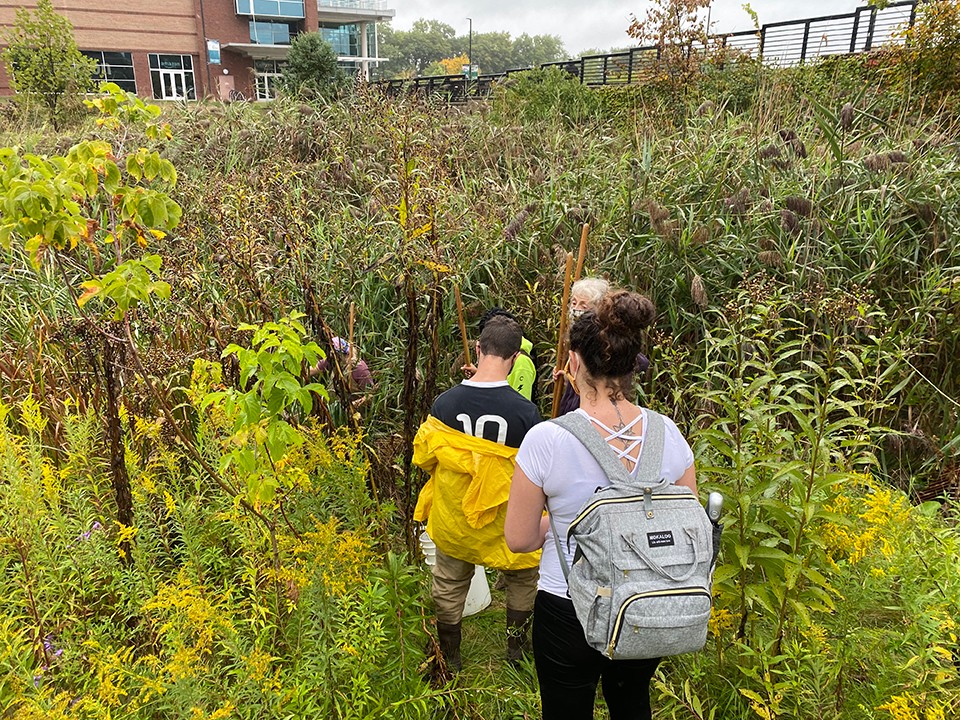Slugs, snakes and salamanders, oh my! Cara Shillington’s biology classes at Eastern Michigan University enjoy distinct outdoor explorations

YPSILANTI – Holding a Leopard Slug. Reaching out to wrangle and grab a snake for your classmates. Seeing the subtleties of salamanders.
An unprecedented fall semester has offered different and distinct opportunities for Eastern Michigan University students, among them the experiences enjoyed by members of Professor Cara Shillington’s introduction to biology classes
Shillington moved some classes outdoors this fall, both to give students a new experience and for the health and emotional benefits of being outside and amid the environment as much as possible. And the weather, bless its fickle heart, mostly cooperated.
Turning over logs looking for critters
“It was amazing how many students said they had never spent time outside turning over logs looking for critters,” Shillington says, reflecting on the excellent experiences already this fall.
The students could be seen collecting samples from some of the marsh areas on campus, such as outside the Science Complex near the bridge at the west entrance. Among the activities was collecting water samples so that students could then spend time looking at the different microscopic and macroscopic organisms.
“These include many unicellular and small multicellular organisms,” Shillington said. “They are so beautiful to see under the microscope – there are different colors and different moving parts – and some zoom across the screen while others are easier to track. The diversity and sheer numbers is amazing to see.”
In preparing for the lab, Shillington and her grad assistants spent a large amount of time looking at different droplets of water. During the lab, some of the students were able to take some good videos just using their cell phones through the ocular lens on the microscope. In each lab group, three students had to put on the waders to collect the water samples.
“For the most part, we had great weather and it was a great excuse to enjoy the fall days outside of the lab room,” Shillington said.
Snake wranglers
The students also visited nearby Cherry Hill Nature Preserve, in Superior Township. There, students had to find as many different animal groups as possible.
“As usual, the vertebrates were a big success, and everyone saw snakes, frogs, and salamanders as well as birds and non-human mammals,” Shillington said. “In each lab group we had some great snake wranglers - students that were happy to reach out and grab the snakes so that everyone who wanted would have a chance to touch or hold them.”
Garrett Wainstock, a student in the class, noted how the class used sweep nets in a grassy field to gather specimens (mostly arthropods like insects, spiders and pill bugs), then dumped them on white sheets for observation. Prime photo opportunities abounded.
"Earlier, we sat quietly and absorbed the environment for a good 10 minutes," he said. "There’s a faint 'nature hum' that breaks into recognizable sounds when you finally stop to listen closely. Those noises that usually blend into the background become clearer and you realize how that homogenous, flat sound is constructed by an awesome variety of creatures."
Shillington’s favorite creature of that visit? That ole Leopard Slug.
“My students weren't as enamored as I was, but several of them did hold the slug,” she said.
Lessons learned all over
The outdoor adventures were new labs that Shillington and her grad assistants set up to reduce some of the time spent in the classroom, while still engaging with the concepts traditionally covered in the class.
"The experience was fun and educational," said Peter Landor, a student in the class. "We got a small taste of what it might be like to be a scientist out in the field. We were learning about the hierarchical classification of animals and what things group species together or set them apart.
"So being able to see examples of organisms from most of the main phyla we have been studying, and being able to see these different traits and adaptations presented to us in a way that is not just in a book or in a zoom room powerpoint slide, was an exciting way to apply what we have been learning."
And those teaching picked up a few lessons as well.
“I think it was a success all round, with both students and the lab instructors, so we will likely try and incorporate some of these activities into future semesters,” Shillington said.
“A positive outcome from a sometimes trying semester.”
About Eastern Michigan University
Founded in 1849, Eastern is the second oldest public university in Michigan. It currently serves nearly 18,000 students pursuing undergraduate, graduate, specialist, doctoral and certificate degrees in the arts, sciences and professions. In all, more than 300 majors, minors and concentrations are delivered through the University's Colleges of Arts and Sciences; Business; Education; Engineering and Technology; Health and Human Services; and, its graduate school. EMU is regularly recognized by national publications for its excellence, diversity, and commitment to applied education. For more information about Eastern Michigan University, visit the University's website.
October 21, 2020
Written by:
Geoff Larcom
Media Contact:
Geoff Larcom
glarcom@emich.edu
734-487-4400
More Stories

Eastern Michigan University awards Summer Research and Creative Activity Grants.

Eastern Michigan University to launch new Bachelor of Business Administration in Financial Planning and Wealth Management degree.

Eastern Michigan University empowers student-faculty collaboration with Undergraduate Symposium Research Fellow Awards.

Eastern Michigan University senior Raya Lasiewski inspires hope and healing through personal journey with eating disorder.

Veteran exceeds limits to becoming an Eastern Michigan University graduate.

